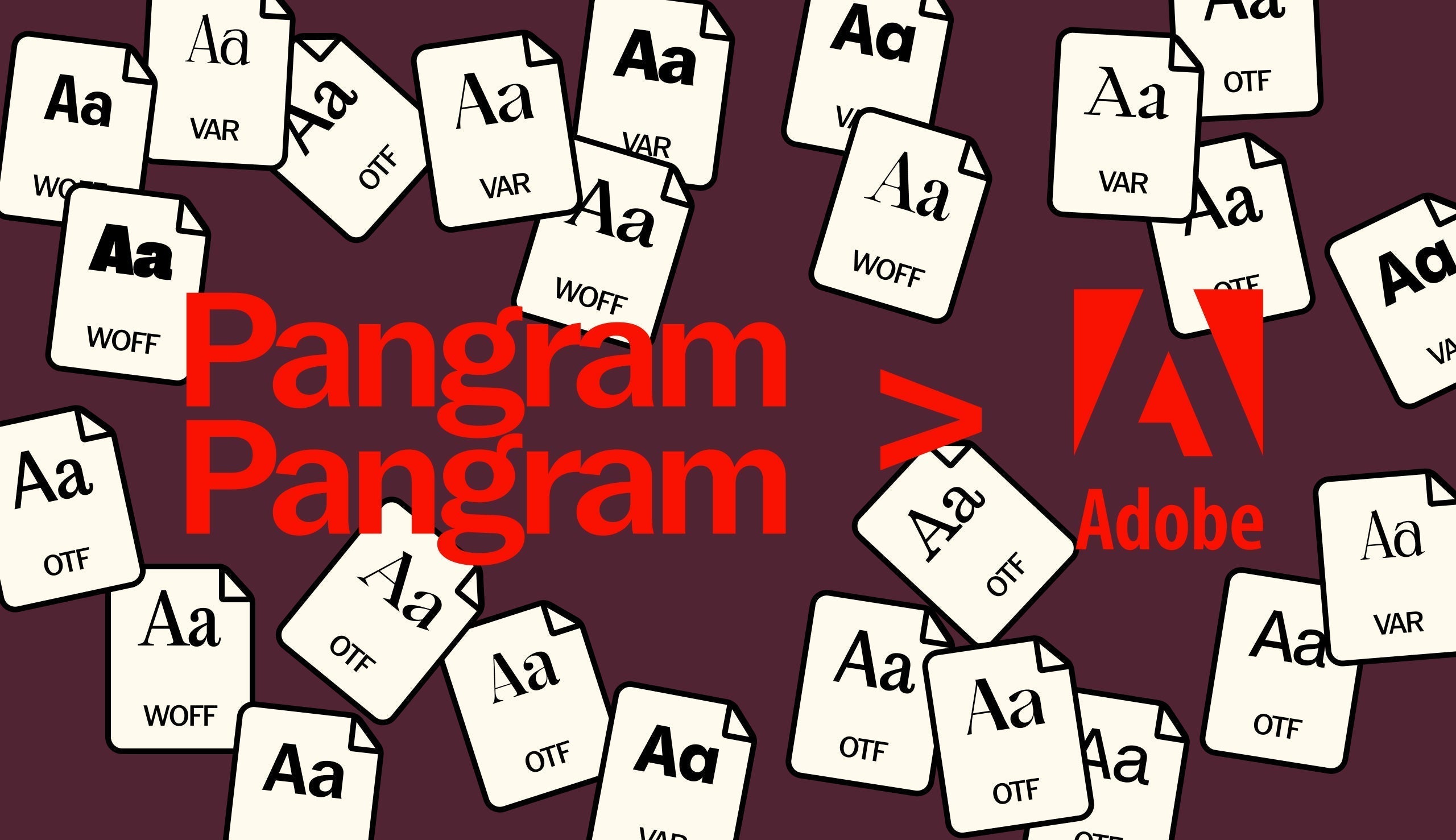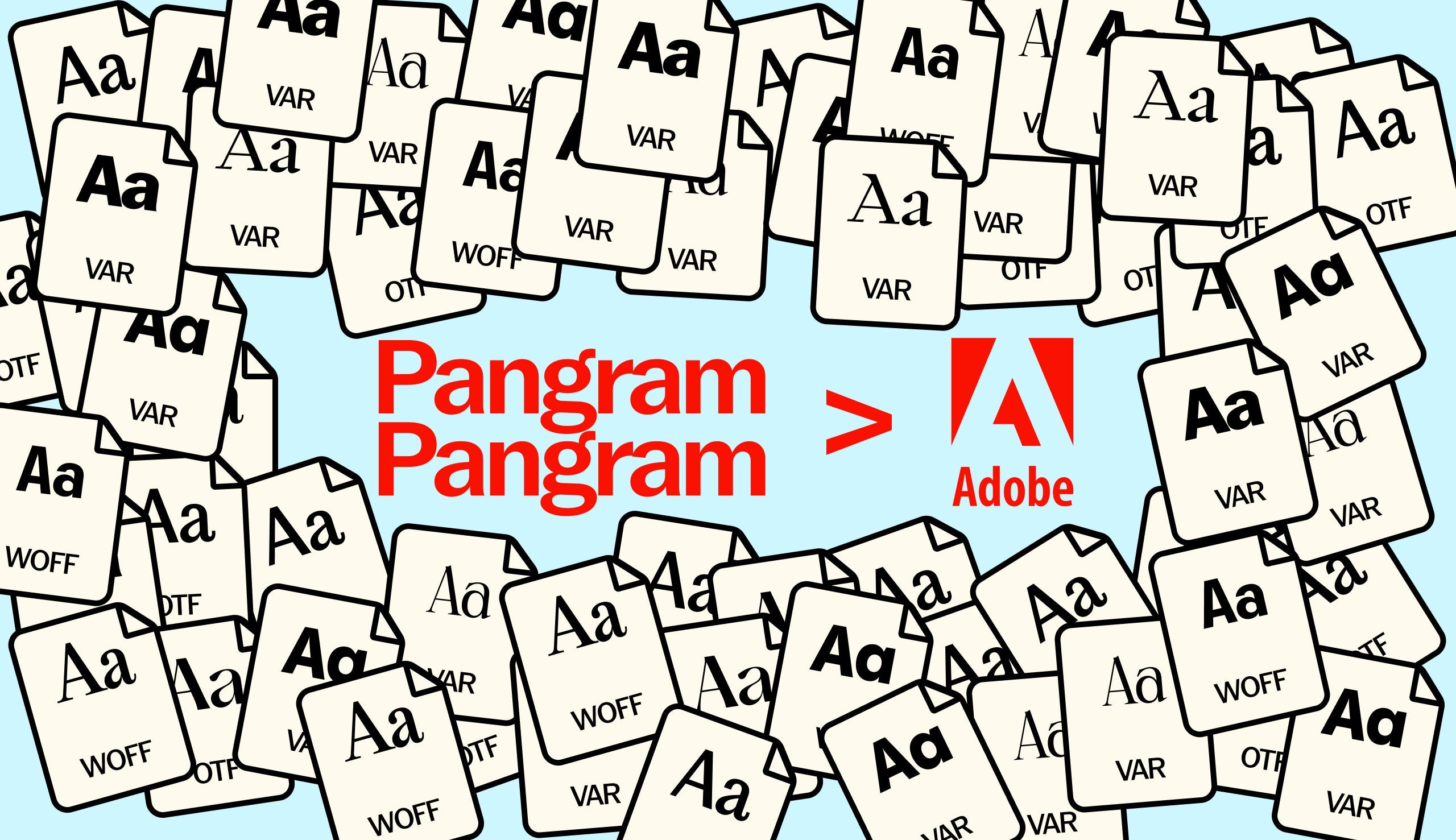Welcome to backstage – a peek behind the curtain of Pangram’s latest typeface – Air.
Beautifully crafted over a period of 2 years, the typeface is a celebration of purity and reduction. A harmonious collision of brutalism, minimalism, and Aerospace engineering, Air leans deeply into Pangram’s philosophy of designing really well made, expertly crafted typefaces that function, whilst retaining plenty of unique character. Versatile at small sizes, but endlessly intriguing and surprising when used much bigger (or inflated, if we’re really sticking with the Air theme here), Air is sure to blow you off your feet.
With an extraordinary 36 weights, a sans and mono family with an abundance of alternates, and a shared language of monospace details embedded into even the proportional cut, the typeface is expansive and intriguing from the lightest forms to the densest. Characters such as the y bring rhythm and charm to its otherwise utilitarian forms, constructing a typeface that would feel equally as at home on an analogue typewriter as on a quantum computer.
A true collaboration between Pangram founder Mat and the long time collaborator Caio, we caught up with the talented pair to delve into the details behind Air, unearthing their collaborative ins and outs. Ultimately learning what takes something from just a good idea, and makes it a reality.
Hey Caio and Mat! So great to be chatting with you both again! Howʼve you been?
MAT: Busy! Excited! Happy with the launch of Air that’s been a long time coming!
CAIO: Excited about the opportunity to talk about Air! 😀
Letʼs talk about PP Air, what a typeface! Start to finish, how long did the font take to craft?
MAT: A while!! 🥵From start to finish, I’d say about 2 years. I worked on & off on it for a good part of 2021 when I finally ended it over to Caio in 2022. Caio spent another good amount of time on it after that. I feel this was one of the best examples of a perfect collaboration!
CAIO: As Mat mentioned, the development of Air took a considerable amount of time. However, I have the feeling that the process was completed relatively quickly, considering the number of styles and characters covered by Air.

What’s the concept behind PP Air? Where did the idea come from? 🤔
MAT: Initially there were a few references and details I had in mind like the awkward-ish G and Y or the bottom of some numbers breaking the ascender and baseline a bit like typewriter fonts. I knew I wanted to do a “monospacey” looking typeface as well. The actual monospace cut came later in the process with Caio. This is why you can notice some monospace elements in the proportional cut i.e.: the r. I was also focusing on the lighter weights at first, I wanted something that was strong yet elegant. Everything really came together when Caio took it over to expand the full style range. I’ll let him take over for this part.
CAIO: Right from the beginning, Mat and I had a conversation about his expectations for this project, but he always gave me complete creative freedom to explore new paths. Throughout the process, there were several moments (and there were quite a few) where I let my creativity run wild, but Mat always brought me back to reality, helping me refine and enhance my crazy ideas. He always kept me focused on the original concept of the Air.


Where and what were you drawing on for references?
MAT: Like I mentioned, a few other vintage typefaces that had some interesting details, typewriter fonts, contemporary brands. I even spent a lot of time researching numbers/letters on old watch dials. Some of the shapes there are really good!
So the typeface was a collaborative endeavour, how was the work split between the two of you?
MAT: I started by creating a lot of the design elements and details in the lighter weights to really settle the concept and do all the exploration. Once I was happy with this first step I had a chat with Caio to see if he was interested in taking this a step further. He said yes and this is when the concept really took flight. Caio added his flawless touch and brought some new ideas that consolidated the idea into a complete project.
CAIO: When Mat showed me his original design, I immediately became excited and accepted the invitation without hesitation!
My main focus was on expanding the character map and broadening the typographic family as a whole. Additionally, I worked on creating monospaced and italic variations, as well as incorporating a variable font.
Throughout the process, we maintained a fluid communication that was absolutely crucial for the success of the project. Our constant conversations allowed us to exchange ideas, share feedback, and make adjustments whenever necessary. This ongoing and open collaboration was instrumental in ensuring that every detail of the typography was carefully refined.

Were there any big key moments during its development, or an ‘Iʼve got it!ʼ moment?
MAT: For me, I think it was when Caio showed me the Monospace and the different alternates that the font could have. Everything made so much sense and I felt that the typeface went from a really good idea to a really good product.
CAIO: I fully agree with Mat. The inclusion of the monospaced style in the font significantly expanded our repertoire of shapes and allowed for the emergence of new and exciting ideas.




The typeface has this wonderful, airy sense of simplicity, whilst drawing on some true brutalist references – how did you find the balance between the two?
MAT: This is what I personally like in type design. Having something very useful with some unique details. In this case, a bit like Neue Machina for example, the idea was to integrate some unexpected moments in the type to achieve this brutalist goal. So that when you use it at small sizes, it feels very solid and versatile but when you blow it up you see those nice curves and connections that are almost creating ink traps, the monospace influence in the proportional, the protruding terminals in a few characters and the surprising unique shapes.

Was it a challenge to keep PP Air’s distinctive aeronautical fluidity when designing its monospace style – how did you overcome the task?
MAT: I’ll let Caio expand on this but from my perspective, the key aeronautical elements came from the curves and connections which are present in both the proportional and monospace.
CAIO: I can confidently say that this was one of the most challenging tasks throughout the entire process. In the heavier weights, the amount of available space was quite limited, which posed a major challenge.
We encountered various situations where we needed to adjust the proportion of spaces to ensure a perfect fit of curves and connections, such as Y, W, M, m, and w. In addition to those, st, sr, and si ligatures proved to be true challenges. The letter "s" is one of the iconic characters of the system, and maintaining its consistent personality across different styles was complex. We overcame this through trial and error, and when I couldn't identify these inconsistencies, I sought Mat's help, and together we explored different solutions. It was a continuous learning process and a collaborative effort in solving these issues.
Alright, time for some quick fire Qs! Whatʼs your favourite glyph in PP Air?
MAT: Ahhh the classic question! Love all the different Ss with their alternates, the G, the Y, the Rr and some of the numbers 1, 3, 4 & 5.
CAIO: I think there's no discussion, haha. The Y is my favourite letter, I drew a lot of inspiration from it to create new characters. It carries a unique personality.




Do you have a favourite PP Air Style?
MAT: I have a soft spot for the lighter weights as the concept stemmed from those but all of them have their own personality which I think is another huge strength of this typeface. Every style has its own vibe. Extralight feels very different from Black Mono while retaining the same key elements.
CAIO: The Black mono italic is the style that holds a special place in my heart. They posed the biggest challenge during the font expansion process, and I believe that's why they have a special meaning to me.
What was the most fun letterform alternative to craft and why?
MAT: Again, Caio did a lot more drawing than me in the end but for me it was the terminals of the uppercase, the lowercase a and s.
CAIO: I really enjoyed creating the 'a' lowercase alternates, which explains why Air has so many of them!
Now you’ve tackled air, what would PP Earth or PP Water look like?
MAT: Actually! When I first thought of the concept for Air, I thought about having a type for all 4 elements! PP Earth might be some kind of strong Slab, PP water, a fluid/organic serif and PP Fire would probably be a super experimental/brutal pointy type but all of this is still very speculative!!
CAIO: I never stopped to think about how that would be, but it would definitely be a great addition to the typeface family, haha.
In a dream world, where would you love to see PP Air being used? A dream client, brand or anything else you might like!
MAT: At the very beginning, a small part of the concept of Air was rooted in some Nike visuals - also part of the reason it’s called Air! Obviously the concept evolved a lot since but I’d love to see a long time client of ours like Nike use this one. Would be a nice full circle moment!
CAIO: I can't pick a specific one, but ever since I started collaborating with Pangram Pangram, there have been so many cool uses. I'm sure I'll have pleasant surprises!
PP Air is available to try for free
Commercial licenses are also available, starting at $40.








